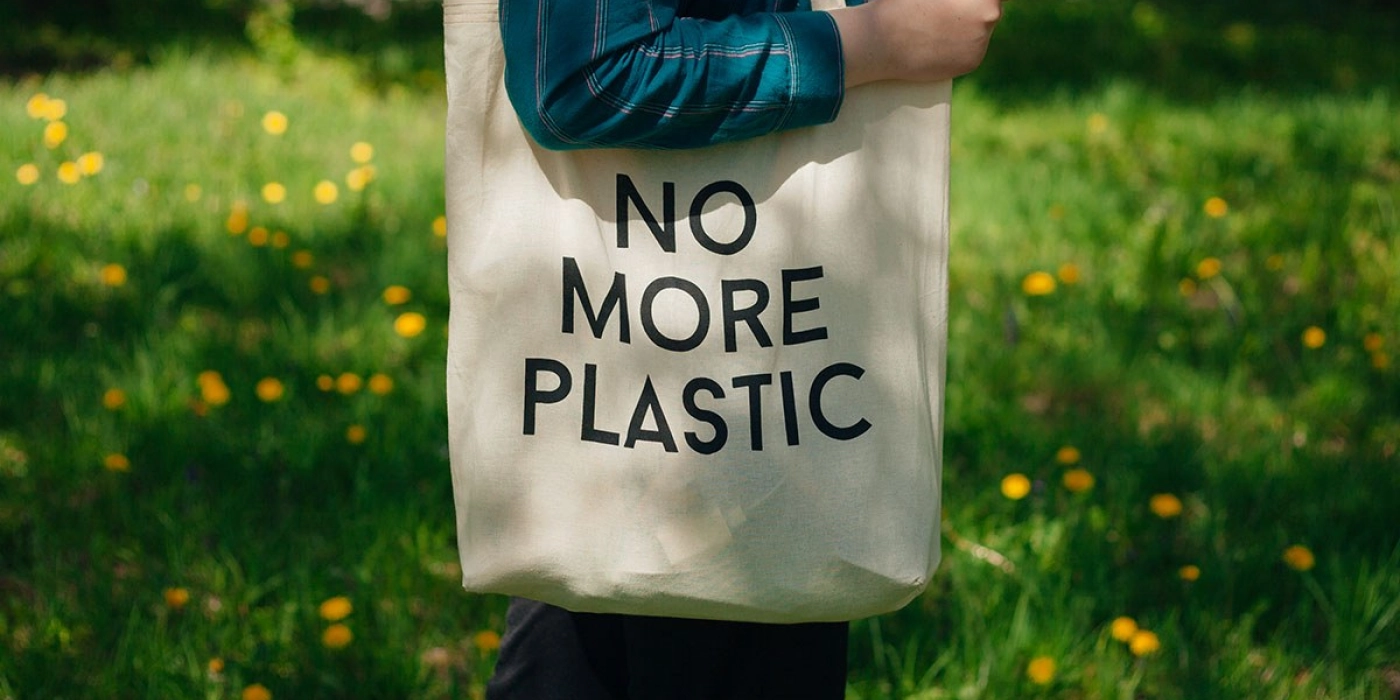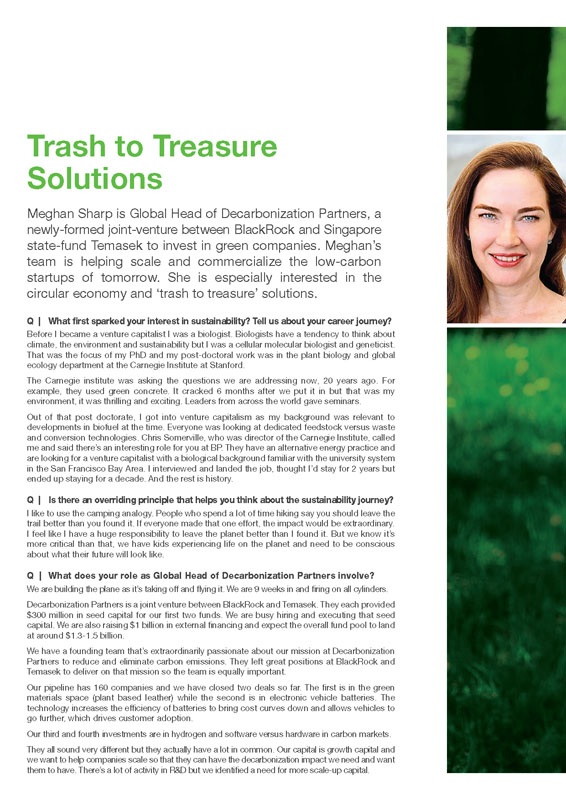-
We are raising $1 billion in external financing and expect the overall fund pool to land at around $1.3-1.5 billion
-
Our pipeline has 160 companies and we have closed two deals so far including in the green materials space - plant based leather
-
When I look to 2050, I see fleets of EVs in parking lots attached to big battery packs attached to buildings
What first sparked your interest in sustainability? Tell us about your career journey?
Before I became a venture capitalist I was a biologist. Biologists have a tendency to think about climate, the environment and sustainability but I was a cellular molecular biologist and geneticist. That was the focus of my PhD and my post-doctoral work was in the plant biology and global ecology department at the Carnegie Institute at Stanford.
The Carnegie institute was asking the questions we are addressing now, 20 years ago. For example, they used green concrete. It cracked 6 months after we put it in but that was my environment, it was thrilling and exciting. Leaders from across the world gave seminars.
Out of that post doctorate, I got into venture capitalism as my background was relevant to developments in biofuel at the time. Chris Somerville, who was director of the Carnegie Institute, called me and said there’s an interesting role for you at BP. They have an alternative energy practice and are looking for a venture capitalist with a biological background familiar with the university system in the San Francisco Bay Area. I interviewed and landed the job, thought I’d stay for 2 years but ended up staying for a decade. And the rest is history.
What does your role as Global Head of Decarbonization Partners involve?
We are building the plane as it’s taking off and flying it. We are 9 weeks in and firing on all cylinders.
Decarbonization Partners is a joint venture between BlackRock and Temasek. They each provided $300 million in seed capital for our first two funds. We are busy hiring and executing that seed capital. We are also raising $1 billion in external financing and expect the overall fund pool to land at around $1.3-1.5 billion.
We have a founding team that’s extraordinarily passionate about our mission at Decarbonization Partners to reduce and eliminate carbon emissions. They left great positions at BlackRock and Temasek to deliver on that mission so the team is equally important.
Our pipeline has 160 companies and we have closed two deals so far. The first is in the green materials space (plant based leather) while the second is in electronic vehicle batteries. The technology increases the efficiency of batteries to bring cost curves down and allows vehicles to go further, which drives customer adoption.
Our third and fourth investments are in hydrogen and software versus hardware in carbon markets.
They all sound very different but they actually have a lot in common. Our capital is growth capital and we want to help companies scale so that they can have the decarbonization impact we need and want them to have. There’s a lot of activity in R&D but we identified a need for more scale-up capital.
We are focused on investing post-pilot to help these startups build their first commercial facilities to provide real volumes and gain their first customers even if revenues are small to begin with. In essence, we are taking scale-up risk.
What strengths do each JV partner bring and does 1+1 =3?
BlackRock and Temasek saw exactly that opportunity. They have a long partnership of working together so saw the chance to double down and create that synergistic effect.
Temasek has invested in early and late stage funds and they have some activity in early venture growth. We are doing mainly series C +D rounds and some B which translates into about $50-100mn per company.
Larry Fink’s CEO letters show a strong commitment to sustainability through private and public markets including an $18 billion infrastructure platform and $9 billion dedicated to renewable power.
How does 1+1= 3? It needs to = 10 to solve this problem. If Decarbonization Partners comes in at the parent level, BlackRock can offer project finance to help with plants. It can help startups with public markets, IPO rounds and debt capital. It can support companies through the entire capital stack. It’s really powerful when we talk about these alternative sources of capital and targeted financial instruments to get where we need to go. BlackRock brings that through a single partner.
What Temasek brings to the table and what resonates with companies is the connections in Asia. We see 20% of our pipeline coming directly from Asia and Temasek is supporting that but the bigger piece of the Asia story is that almost every company we invest in, if they grow and are successful beyond the first few plants, they are looking to Asia for future growth.
Understanding the regulatory environment and financing mechanisms, these things are not trivial so having a partner like Temasek in the region is incredibly powerful. It’s exactly why I’m here – I decided it was a career opportunity of a lifetime to have 2 extraordinary institutions bringing very different but complimentary things to the table.
What are the most important factors you consider when making a green investment?
We want to see opportunities that have been technology de-risked and proven beyond the R&D stage.
Firstly, are these companies ready to scale? Each investment needs to have a 20% plus internal rate of return (IRR) for investors, as well as a decarbonization effect, and both are equally important. These are dual-purpose funds.
Secondly, is the technology largely proven, are they ready to scale? Thirdly, customer traction and those first revenues.
Our first two deals were mid-30s IRR in a conservative model. As part of our due diligence, we want to see companies bringing down cost curves so that they are competitive with more carbon intensive counterparts where that’s an appropriate comparison to make.
We see opportunities for significant returns to investors and for these types of technologies, they will have to be commercially successful to have a decarbonization impact. They will hit those IRRs if they are scaling.
What themes and sectors you are concentrating on?
Our four main themes are 1. Electrification of everything in a 2050 future - Mobility, industry and buildings; 2. Clean and reliable energy generation and storage; 3. Green materials; and 4. The circular economy.
At a granular level, the sectors are bio and low carbon products, carbon management, carbon capture, storage and utilization, renewable power and digital transformation. Without digital, the hardware piece will not work.
What are the future green energies you are most excited about?
Aspirationally, I get excited about trash to treasure solutions. For example, I love to see municipal waste being turned into something valuable like sustainable aviation fuel.
We are looking at recycling tires. It sounds boring but it’s really important. Tires are building up in landfill, it’s a horrible environmental hazard. Circular economy solutions get me excited, it’s a form of upcycling.
More broadly, steel and concrete are big ticket items when you look at where our carbon emissions come from. We don’t currently have one in our portfolio but it’s early days.
What are the biggest challenges in reaching net zero?
Being as efficient and optimized as possible, is essential if we are to have any hope of reaching net zero. When I look to 2050, I see fleets of EVs in parking lots attached to big battery packs attached to buildings and at any point in time we have digital infrastructure and AI managing all that energy supply and demand. When does it go to the fleet, when to buildings? We will have renewable power on roofs of building. Everything will have to be connected to make it work.
Disclaimer
This content has been prepared by Nomura solely for information purposes, and is not an offer to buy or sell or provide (as the case may be) or a solicitation of an offer to buy or sell or enter into any agreement with respect to any security, product, service (including but not limited to investment advisory services) or investment. The opinions expressed in the content do not constitute investment advice and independent advice should be sought where appropriate.The content contains general information only and does not take into account the individual objectives, financial situation or needs of a person. All information, opinions and estimates expressed in the content are current as of the date of publication, are subject to change without notice, and may become outdated over time. To the extent that any materials or investment services on or referred to in the content are construed to be regulated activities under the local laws of any jurisdiction and are made available to persons resident in such jurisdiction, they shall only be made available through appropriately licenced Nomura entities in that jurisdiction or otherwise through Nomura entities that are exempt from applicable licensing and regulatory requirements in that jurisdiction. For more information please go to https://www.nomuraholdings.com/policy/terms.html.

